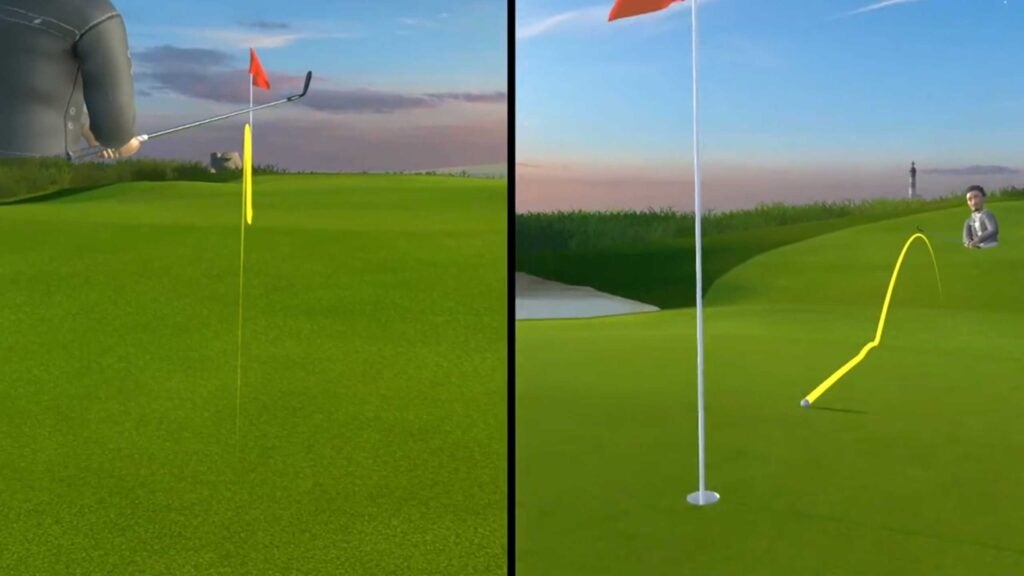I don’t often play video games at work.
Tempting as it may be, I have long believed the line between “gainful employment” and “filing for unemployment” rests somewhere between the first and third games of PGA Tour 2K23 on, say, a Tuesday afternoon. Nobody — no matter how passionate — wants to get caught controller-in-hand while their boss is trying frantically to reach them.
But some rules, as the saying goes, were meant to be broken. And on a recent morning in the GOLF.com offices, that’s precisely what happened.
There I was, in the midst of an early-morning virtual round on the Ocean Course at Kiawah Island, when I heard a voice. It was Alan Bastable, GOLF’s executive editor (and my boss), standing just a few feet in front of me.
“…Dude?”
“Oh! Hey!” I stammered, backing away slowly.
“What’s going on here?” Alan asked.
It was abundantly clear what was happening. Alan had caught me in the act, Oculus headset on, floundering joyfully through a virtual reality golf course when I should have been working. Just a few feet to my right, the team responsible for making the video game, GOLF+, looked on gleefully. Or at least, they sounded gleeful. I was immersed in the virtual world around me, unable to see the room I stood in or the people who shared the space with me.
I held a device that resembled a golf club in my hands, the grip giving way to a steel shaft, which attached at its midpoint to a device resembling a Nintendo Wii controller. With the headset over my eyes, I was absorbed — all 360 degrees — in the virtual world around me, a landscape that could have been plucked straight from the copy of 2K22 in my living room. It was time to play my first round of VR golf…in front of my boss.
Inside the golf industry, GOLF+ is enjoying a healthy dose of newfound celebrity. The brainchild of Ryan Engle, an Austin-based tech wunderkind and obsessive golfer, the app owns something of a first-mover advantage in the topsy-turvy world of VR. It is among the only golf-focused apps currently available to users, and it is by far the most well-funded, having raised millions from a glittering list of investors that includes Rory McIlroy, Tom Brady and Ben Crenshaw. In the months since that announcement, GOLF+ has exploded into the golf space, announcing partnerships with TaylorMade, Pinehurst Resort and Pebble Beach. On Thursday morning, the PGA Tour announced that it, too, had partnered with GOLF+, bringing the complete suite of TPC courses to the app in a move that will make GOLF+ the “official virtual reality golf game” of the Tour. (GOLF.com and GOLF+ have no business affiliation.)
Inside the app, it’s easy to understand the hype. Golfers can simulate the experience of playing actual golf, completing rounds from tee to green in a matter of minutes, minus the walking. To hit a driver, iron or chip shot, users grip the golf club attachment and make a swinging motion as they typically would. While the weighting is different (the controller is considerably lighter than an average club), the ball responds as it does in real golf (my ugly push-slice bears no difference between VR and real life). The putting function — which simulator golf has never quite cracked — is particularly eye-opening; in practice mode, players receive detailed analytics about their stroke, tendencies and potential fixes.
Courses are fully immersive, with true-to-form routings and bunkers — the hard work of what Engle calls a “crack team” of two GOLF+ coders. It takes just two weeks or so for a course to go from laser-mapped to ready for gameplay; the relative speediness of this process has allowed GOLF+ to add a catalog of new courses in just the last two months, with more on the way.
But back in reality, the picture isn’t quite as rosy. Meta, the parent company to Facebook and godfather of VR, has seen its share value nosedive in 2022 after reporting disastrous earnings related to its $10 billion investment in VR. Competition from within the tech industry, once expected to be a key factor in driving down costs, has slowed in some cases, and stalled all together in others.
Then there’s the technical issues still facing the platform. The Oculus headset, which is required for use, is still quite costly ($399) and uncomfortable when worn for long stretches of time. The operating software is prone to glitches and other hiccups. And while VR visuals are quite impressive on the whole, they’re still a long way from anyone’s definition of “lifelike.”
When I posed this quandary to Engle, he offered a counterargument. Of all tech products, he said, the growth curve of the Oculus most closely resembles the iPhone. Significant advancements in both hardware and software have proven expensive, but they’re not far off, he said. Soon, he predicted, the barrier to entry won’t feel quite as large to average video game consumers, and once consumer demand explodes, the resultant investment will improve the product just as quickly.
Then the possibilities for GOLF+ will be truly limitless: better headsets, better graphics, more realistic swing mechanics. One future advancement that has Engle particularly excited is the platform’s ability to turn architectural drawings into honest-to-goodness digital designs, bringing to life “ghost courses” — courses that were designed but never built.
If it sounds a little far-fetched, that’s because it is. This is, after all, the central thesis of the tech industry: It always seems impossible…until someone else does it.
Just as Engle said that, the two of us were interrupted. To our right, my boss Alan was trying on the headset for the first time. We watched as Alan hit his first putts, marveling at the brave new golfy world in which he had found himself.
“Wow,” Alan said, his jaw slightly agape. “This is wild.“
Ryan turned in my direction and smiled. He had made his point.
